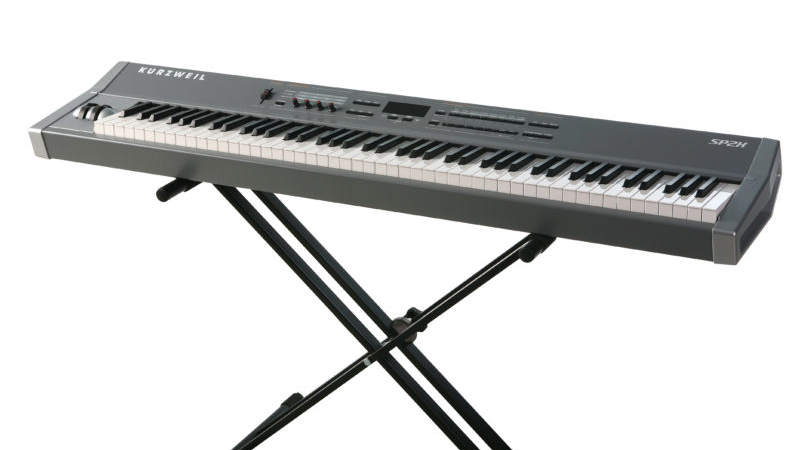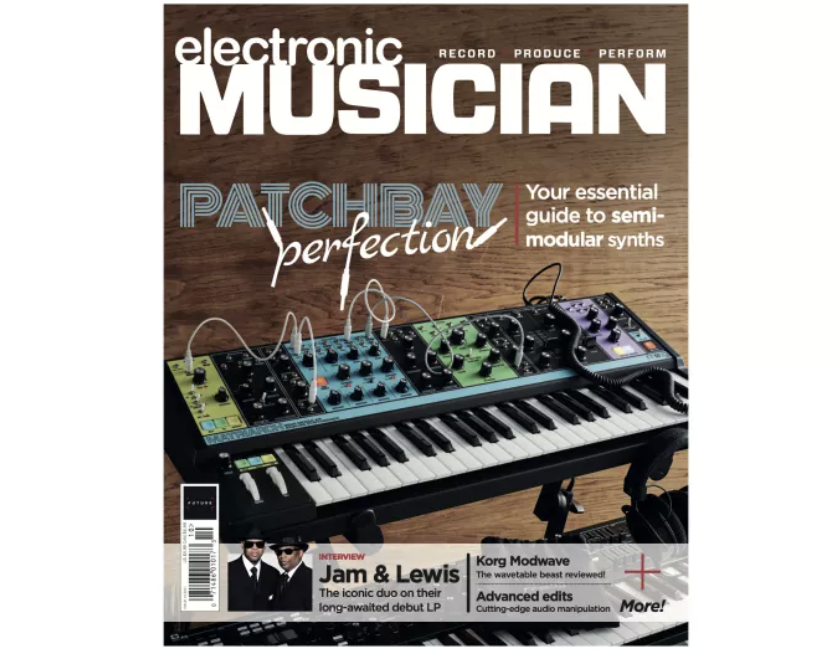Kurzweil SP2X stage piano review
Kurzweil''s SP2X is an 88-key weighted-action digital stage piano

Kurzweil's new SP2X is an 88-key weighted-action digital stage piano. The unit is a model of simplicity and quality, an eminently playable instrument well suited to the practice room or the casual circuit.
The SP2X is built for gigging. The overall design is of sleek lines and minimal extra baggage. The main chassis is made of metal with smooth, rounded edges, and the end caps are made of hard plastic. I don't know how well the end caps would survive a drop to the floor, but they look solid enough to withstand minor impacts. The control surface is gently raked upward to improve visibility and access. The colour scheme is in neutral silvers and greys, and the look is modern but not sci-fi. This piano was designed to call attention to the player, not the instrument.
There is just enough extra space at the lower end of the keyboard for full-size modulation and pitch wheels. The end caps are indented, creating a natural ledge for lifting and moving the instrument. I'm delighted at its moderate weight: 48.5 pounds. To be able to have a good 88-key action within a solidly constructed case at a weight that is reasonable for gigging is terrific. One gripe is the SP2X's use of a line lump rather than an internal power supply. In the chaos of a gigging situation, it is all too easy for ancillary items to get left behind.
The SP2X's action is fully weighted and feels great to play. There's sufficient resistance to allow your fingers something to push against, yet enough give and springiness to allow for machine-gun-fast repeated notes on a single key. The throw is not as deep as the action on my acoustic piano, but this fairly short key depth makes for a pretty fast action, you can rip lightning-quick runs up and down the SP2X's keyboard. There are seven global Velocity Sensitivity settings, from very light to very heavy. I liked the default, linear setting right out of the box.
The SP2X does not have a dedicated LCD, relying instead on a large, 3-digit, old-school-style LED readout. For the most part, this design decision keeps things simple. However, it also requires memorizing the locations of your favourite patches. Fortunately, the unit has a quick-access bank, which allows you to recall your 16 favourite programs and setups with one button press.
Four data knobs work in conjunction with a 3-way knob mode switch to give you a matrix of 12 knob functions. These functions include acting as MIDI continuous controllers; controlling the zone's main, layer, split, and rhythm levels; adjusting the effects settings; and setting the rhythm track's tempo. Each user setup stores and recalls patch, split, and effects settings and mix levels.
A series of dedicated mode buttons is designed to let you quickly turn reverb and other effects on or off, as well as assign layers and split points. Another series of buttons is reserved for editing, transposition, and key- and Velocity-range selection. In the middle of the panel are two rows of eight buttons that are used to select patches, effects algorithms, and rhythm tracks. For patch selection, the top row selects the category (piano, strings, pads, and so on), while the bottom row selects the variation. An automatic layer/split function makes creating layers and splits a fast and easy process. These 8 × 8 groupings make it quick to audition multiple patches within the same category.
Get the MusicRadar Newsletter
Want all the hottest music and gear news, reviews, deals, features and more, direct to your inbox? Sign up here.
The rear panel is equipped with all the outputs that you would expect: a ¼-inch headphone jack, a pair of ¼-inch TRS line outs, ¼-inch sustain and continuous-controller inputs, a USB port for interfacing directly to PCs, and MIDI In/Out/Thru.
Sounds are, of course, what a digital piano is all about, and the SP2X delivers in this department. The flagship sound for the instrument is Kurzweil's Triple Strike Grand Piano. This sample set is used for eight patches, including a bright hard-rock sound and a slightly detuned ragtime sound. The straight-up stereo grand and concert grand patches are the standouts here. The samples are rich, subtle, and even across the keyboard, although you can hear slight timbral differences at boundaries between samples.
Overall, the voicing is moderately bright to my ears. The high treble keys, which can be troublesome in some piano sample sets, sound realistic, without any stretching of samples played beyond their believable range. My only complaint is that the loop section in the bass strings becomes noticeable when holding a single key down for longer than 4 or 5 seconds and listening carefully. However, in a real-world playing scenario, this would rarely happen.
Many of the electric piano sounds are pretty darn good. Fagen Phaser is a credible imitation of the Steely Dan Rhodes sound, and Old Sly Rhds has a bit of touch-sensitive funky midrange bite and a nice Velocity-driven timbral shift. Big Red Wurly sounds authentic to me if you adjust the mod wheel to bring in some Wurlitzer tremolo. None of them sounds good when pushed beyond the range of the original instruments, but if you play them appropriately, they get the job done well.
If classical organ is your thing, Pipe Organ is a huge, rich, all-stops-out organ sound drenched in reverb. Jazz organ doesn't fare as well: Ballad of 3 Bar is the best of the bunch, with a Leslie speed simulation on the mod wheel. The sound can work if organ is an occasional part of your bag of tricks, but if you are relying heavily on organ sounds, you should look for a device particularly suited to that task.
Orch Pad and Film String are both lush, deep string pads well suited to filling space in an arrangement. Williams Brass or Brass Section could be useful for a keyboardist filling in parts for a horn section, but neither is a perfect substitute for the real thing. I really liked the beautiful choir pad sound of Bright Voices, and Old Lead had me dusting off '70s-era Genesis riffs.
The SP2X also has a small but well-chosen set of percussion sounds. Studio Drums 1+2 gives you everything you need to sketch out a rock track, and Virtuoso Perc offers a nice variety of ethnic and hand percussion. Dual Marimba and Vibes both provide nice-sounding and useful impersonations of the real instruments.
Kurzweil is especially proud of its 24-bit effects, stating that its DSP algorithms are of superb quality for products in this price range. The unit offers two simultaneous effects per program: a reverb and an additional effect. The reverbs include the usual rooms, chambers, and halls. The additional effects include chorus, flange, delay, compression, distortion, filter (an auto-wah), Lazerverb (a spacey, echoey, metallic reverb), and “misc.” The misc effect is context-sensitive; on the piano patches, it creates a detuned effect, and on the Hammond patches, it simulates the Leslie speaker.
In keeping with the idea of the simplicity of design, you can't adjust any parameter on the effects except wet/dry mix, what you hear is what you get. Fortunately, the designers focused primarily on creating common, fairly generic effects. The hall and chamber reverb effects are particularly good, with a nice bloom and a clean, smooth tail.
The SP2X's rhythm tracks are a useful aid for practice and composition. These 64 patterns are organized into 8 musical genres: ballads, Latin, country, and so forth. The tempo knob allows you to change the tempo of each groove from 40 to 280 bpm. There's also a metronome that lets you choose between four-time signatures.
The rhythm patterns have been chosen to create a well-rounded collection, but like the effects settings, they are fixed. I wouldn't plan on using them in performance, but as a quick-and-dirty practice tool to help get your timing together, they can't be beaten.
The SP2X has a USB port, making a direct connection with PCs — no MIDI interface required. Unfortunately, drivers are available only for Windows XP at this time, so if you are a Mac user, you will have to use the SP2X's MIDI ports with an external MIDI interface instead.
The SP2X can double as the primary MIDI controller for a modest live rig or studio. The unit supports 16 setups, which are individual configurations of internal sounds and/or MIDI control of external sources. Each setup has four zones, each with its own key and Velocity range, transposition, and MIDI channel. You can also assign the continuous-controller value for each of the four data knobs on a per-setup basis. Programming the setup is hampered a bit by not having an LCD. If you require more-flexible MIDI control and programmability, as well as a more detailed display, you might look to Kurzweil's PC series of keyboards instead.
I love reviewing products that rock. The Kurzweil SP2X is a really well-designed piece of gear that is tailor-made for the gigging keyboard player. The weight and form factor, quality action, useful sound set, simple interface, and modest price make for an appealing product. Add the rhythm tracks and metronome, and you also now have an effective practice and compositional tool. Though the absence of an LCD can be a detriment in some situations, it also keeps things focused on simplicity, which is what this keyboard is all about. If you are in the market for a new gigging piano, the SP2X is worth your consideration.
Keyboard controller $1,251
Pros: No LCD. Relatively light keyboard with quality weighted action. Well-chosen and -executed sample set. Sixty-four rhythm tracks with variable tempo. Sixty-four-voice polyphony.
Cons: No LCD. USB functionality is not currently supported for the Macintosh. You can't program your own rhythm tracks or effects. Line lump power supply.
Features: 3
Ease of use: 5
Sound: 4
Quality: 5
Kurzweil/Young Chang, Inc.
www.kurzweilmusicsystems.com
Electronic Musician magazine is the ultimate resource for musicians who want to make better music, in the studio or onstage. In each and every issue it surveys all aspects of music production - performance, recording, and technology, from studio to stage and offers product news and reviews on the latest equipment and services. Plus, get in-depth tips & techniques, gear reviews, and insights from today’s top artists!










